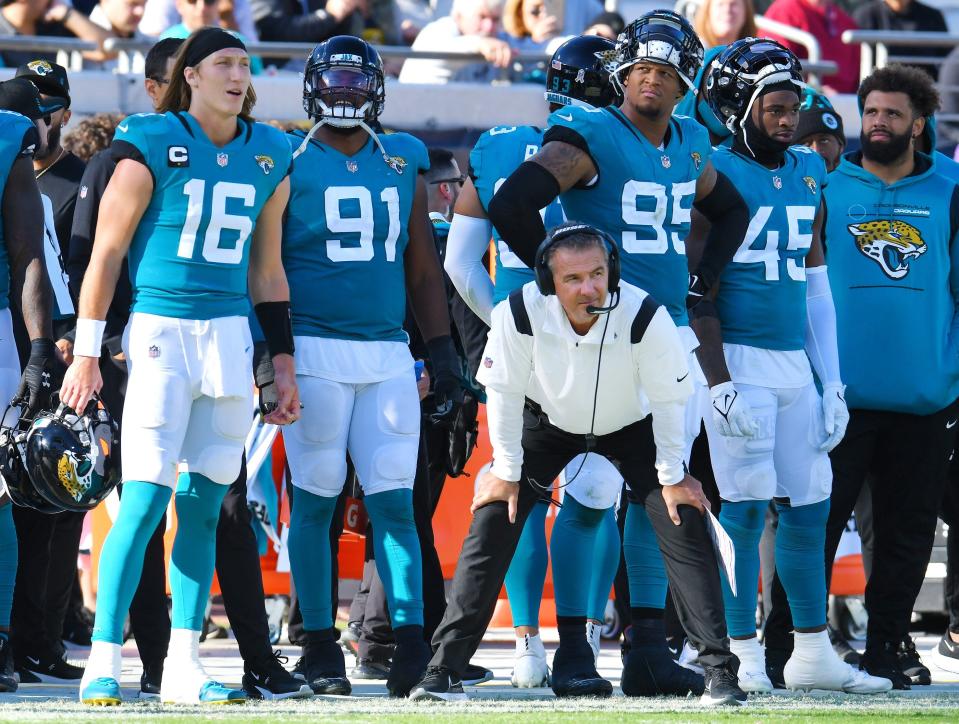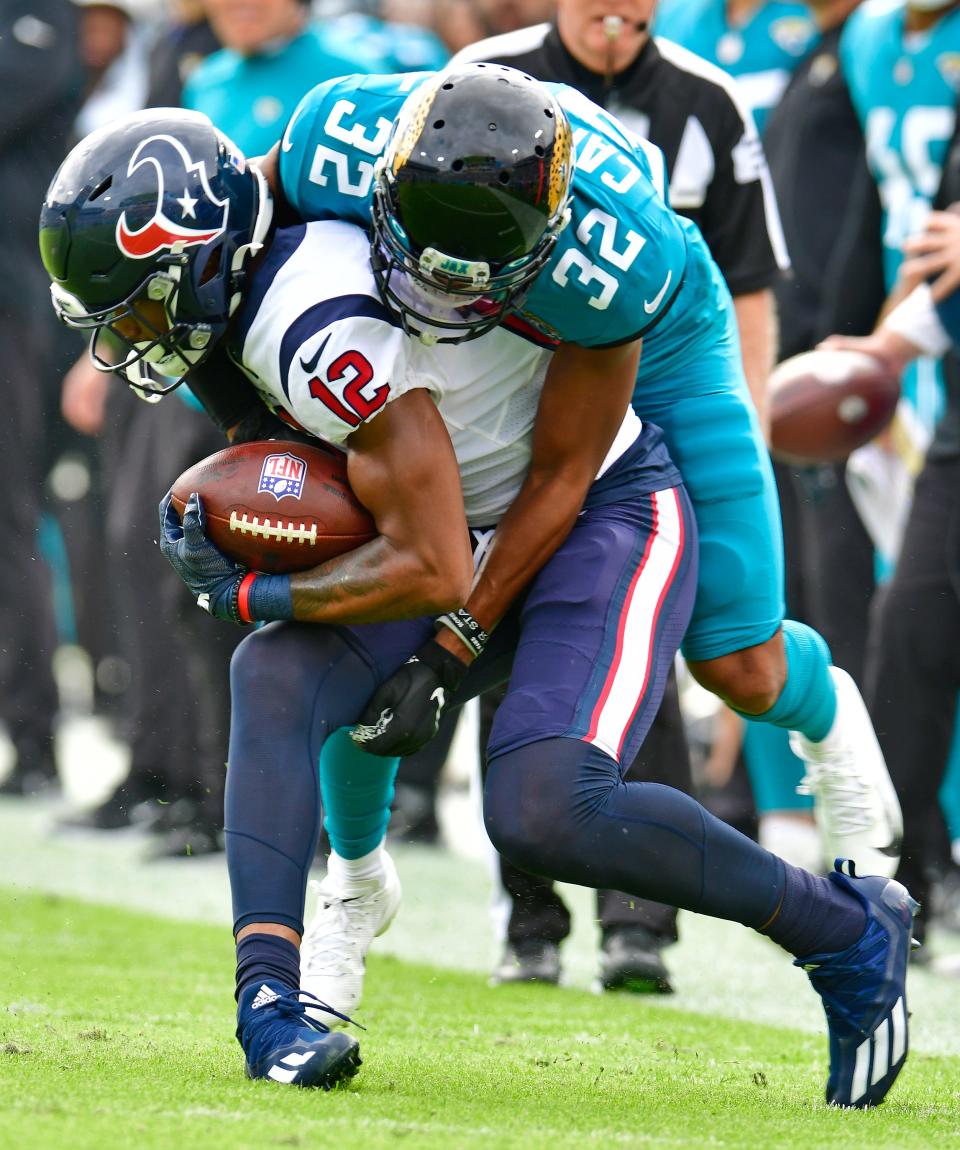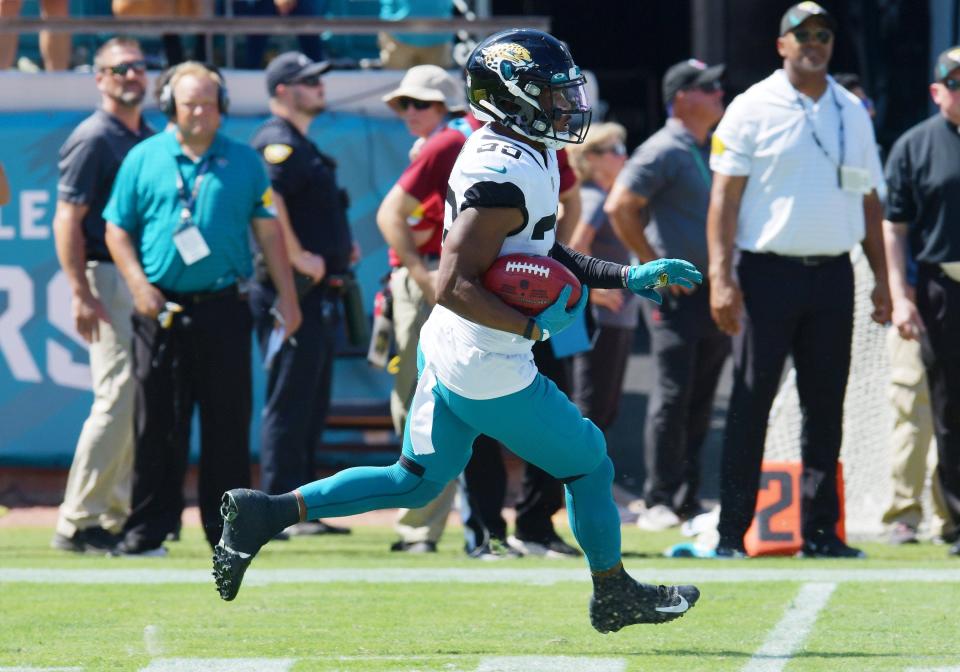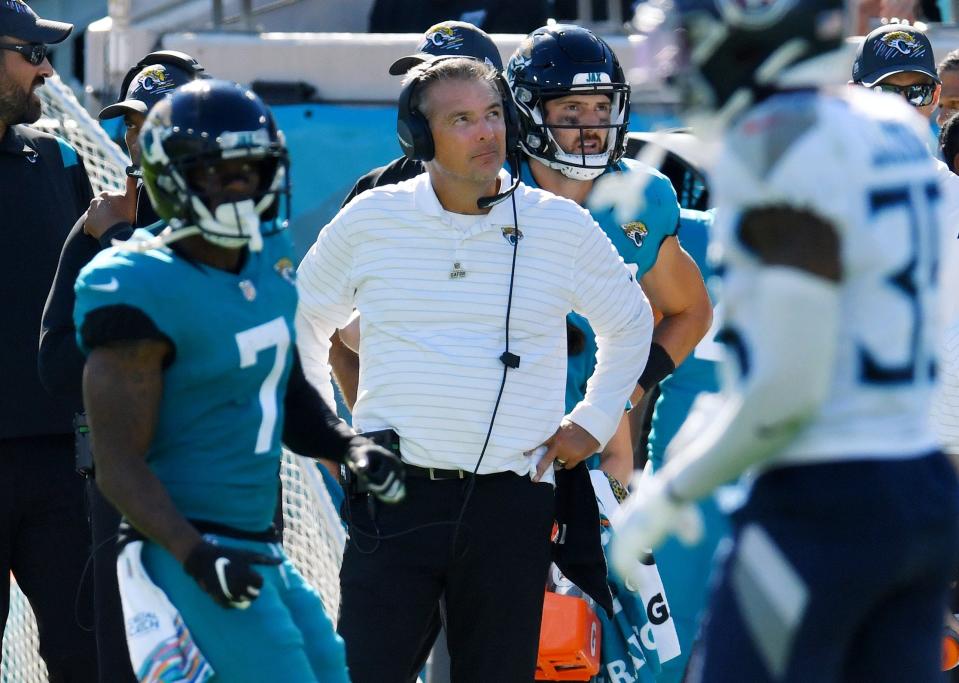No honor roll here: 2021 Jacksonville Jaguars a FF-ailure in annual season grades
From a statistical and visual standpoint, what stood out the most in the Jaguars’ miserable 2021 season is almost every facet of the game failed to show any improvement.
The team whose head coach, Urban Meyer, got fired after just 13 games never took any real steps toward ascending until inexplicably dominating the Indianapolis Colts in the season finale.
Sure, a couple of things got a tad better in the second half of the season like the offense’s third-down conversion rate and reducing penalties. But peeling back the onion — looking at every meaningful performance standard — the Jaguars’ overall body of work in all 14 losses (except the first half against the Cincinnati Bengals) pretty much stayed consistently between sub-par and atrocious across the board.
When a team plays 1,020 minutes of football and holds the lead for only 158 minutes, 12 seconds (one-third of that coming in the last game), yet trails for almost 650 minutes, that amounts to one long, exasperating year.
One Jaguars’ employee candidly, and in a matter-of-fact tone, described the situation facing the Jaguars moving forward this way: “It ain’t a good roster. We don’t have a playmaker anywhere. It’ll take three years, in my opinion, to rebuild this thing. We were a bad football team.”
Gene Frenette: Jacksonville Jaguars' coaching job more attractive with Trevor Lawrence
Gene Frenette: Colts win aside, Jaguars must stop clowning around and fix this franchise
With the individual exceptions of return specialist Jamal Agnew and running back James Robinson before they sustained season-ending injuries, almost every pertinent number on offense, defense and special teams validates that assessment. The Jaguars — from Trevor Lawrence on down – never learned to truly play complementary football until they were hours away from cleaning out their lockers for the season.
The biggest damning statistic was finishing last in the NFL in turnover differential (minus-20) by a wide margin. It didn’t help matters that field position was also a factor in the Jaguars’ misery. They were dead last in the NFL in average starting position (25.7-yard line), while opponents’ average starting position was the 29.7-yard line (ranking the Jaguars 26th).
These overall grades are reflective of a team that struggled to stay competitive most weeks with 10 double-digit losses, endured an excessive amount of Meyer-induced drama, and needs a substantial roster overhaul before it can put out a consistent winning product.

Offense – F
When you throw out the season finale, there is no way to sugarcoat how pathetic this unit looked from the moment the Jaguars got back from London following that first win over the Miami Dolphins on October 17.
No matter which buttons Darrell Bevell pushed as the offensive coordinator — before taking over as interim head coach and handing the play-calling duties to Brian Schottenheimer – almost nothing worked.
You’d certainly expect any rookie quarterback to go through struggles, but Lawrence experienced an inordinate amount of disappointment. He went through a nine-game stretch of throwing only two touchdown passes and had 11 games where his QB rating was under 75.0.
Of the 25 NFL quarterbacks with a minimum 400 attempts, Lawrence was last in yards per attempt (6.0), QB rating (71.9) and completion percentage (59.6 percent). He also tied the Los Angeles Rams’ Matthew Stafford for a league-high 17 interceptions, but had only 12 TD passes to Stafford’s 41.
Lawrence rarely got much of a payoff for those times when his generational talent did shine through because they were such isolated moments. A lot of it had to do with not having the weaponry — with or without Robinson — to move the chains and find the end zone.
The Jaguars set a franchise-record low of 14.9 points per game, including an anemic 13.4 over the last nine games, which includes a season-high 26 points in beating Indianapolis last week.
With such limited help, Lawrence struggled to put up respectable numbers. He operated a vanilla offense with no explosive element. The Jaguars had just 11 plays of 30-plus yards all season, and only two for touchdowns – a 66-yard Jamal Agnew run in the first Colts’ game and a 41-yard catch by DJ Chark in the season opener at Houston. They had 62 of 157 (39.5 percent) full possessions without picking up a first down.
Lacking a true No. 1 receiver, and Chark being lost early in the season to a fractured ankle, only compounded the offense’s impotency. Lawrence was also plagued by an NFL-high 39 drops, according to ESPN Stats, as the Jaguars finished 28th in third-down conversions (35.8 percent). His third-down completion percentage of 51.0 was second-lowest among 26 NFL quarterbacks with a minimum 100 attempts.
Team-leading receiver Marvin Jones, a free-agent pickup, had respectable numbers with 73 catches for 832 yards and four TDs, but nobody was any kind of vertical threat. Laviska Shenault ran almost exclusively crossing routes and slants. He accumulated 389 yards out of 619 after the catch, but never once scored a touchdown among his 63 receptions.
Even when the Jaguars had good field position – only 10 drives started in enemy territory – things somehow got botched up or the play-calling was suspect.
They had a chance to win against the New York Jets, but after having a first-and-goal at the 5, Schottenheimer foolishly instructed Lawrence to spike the ball on third down from the 1 with the clock ticking down to 12 seconds. On fourth down, a pass for Jones fell incomplete as an illegal shift penalty on the Jaguars was declined.
At Cincinnati, with a chance to go up 21-0 before halftime, Lawrence elected to try and run it in on fourth down from the 1 instead of giving the ball to Robinson. That stop turned out to be the momentum-turning play for the Bengals, who rallied for a 24-21 win. With Robinson on the sideline in the first Tennessee game, a fourth-and-1 run resulted in a 3-yard loss for backup running back Carlos Hyde, killing a chance to close the deficit to 31-26.
Contrary to popular belief, the offensive line was not a big liability, though it did incur 11 holding penalties and nine false starts. James Robinson (164 rushes, 767 yards, 4.7 average, 8 TDs) was underutilized, then missed the final two games with an Achilles injury. Lawrence was sacked 32 times, tied for ninth-fewest in the NFL, but the adequate protection was often wasted because receivers didn’t get enough separation or couldn’t hang on to the ball.
You can’t win with an offense that was only functional in five of 17 games. Until the Jaguars find weapons that can scare opponents, including at tight end, it may be a while before they can light up scoreboards.

Defense – C-minus
The good news is this unit under first-year coordinator Joe Cullen showed improvement over last season, but that isn’t saying a whole lot since the 2020 defense allowed a franchise-record 492 points and a whopping 6.3 yards per play.
A rebuilt defense — fortified by acquiring veteran free agents like cornerback Shaquill Griffin, safety Rayshawn Jenkins, linebacker Damien Wilson and linemen Malcom Brown, Roy Robertson-Harris and Jihad Ward — turned out to be a modest upgrade.
The defense delivered two spectacular games by keeping the Super Bowl-contending Buffalo Bills out of the end zone and then putting a vise grip in the season-ending matchup with Indianapolis. In both instances, the Jaguars were slightly more than two-touchdown underdogs at home and pulled off the upset.
At times, this unit did a credible job of forcing opponents to settle for field goals, but it was consistently below-average in too many areas to justify anything more than a meh passing grade.
One big drawback that affected the grade was an inability to generate turnovers. Without the 17th game, the Jaguars would have tied the 2018 San Francisco 49ers for the fewest takeaways in an NFL season with just seven, but a Wilson interception of Carson Wentz and also forcing a Wentz fumble kept them from sharing that dubious honor.
The Jaguars’ inability to force turnovers contributed mightily to the offensive woes because they were constantly losing the field position battle. It’s no coincidence that in the team’s three wins, the defense got six turnovers, but only three in 14 defeats.
After last year’s struggles in affecting the quarterback with a lowly 18 sacks, the Jaguars jumped up to 32, helped immensely by a season-high six in the final game. Sack leader Josh Allen (7.5) reflected the defense’s inconsistency by coming up big in wins over Buffalo and Indy, but also went sackless for a career-high seven straight games.
Dawuane Smoot, who signed a two-year, $14 million contract in March to stay in Jacksonville, proved it was money well spent by registering a career-best six sacks in 676 snaps and a team-leading 16 quarterback hits. He has far outplayed 2020 first-round pick K’Lavon Chaisson, who had one sack and saw his playing time diminish significantly with only 384 snaps, compared to 568 last year.
From a pass coverage standpoint, the Jaguars made dramatic improvement from the first half of the season when they were 31st in yards per attempt (8.4) and completion percentage (71.6 percent), and 30th in pass plays allowed of 20-plus yards at 36.
They reduced the YPA to a final total of 7.6 yards, the overall completion percentage to 69.4 and yielded just 19 passes of 20-plus yards in the last nine games. A big reason for the secondary’s elevated performance was rookie cornerback Tyson Campbell. He struggled in man coverage and finding the ball in the air in the first half, but ended up leading the team in pass breakups (10) and interceptions (2).
Griffin, the team’s most expensive free agent, was lured away from Seattle with a $44.5 million contract and couldn’t deliver any big plays. He failed to grab a few interception chances, including a likely pick-six against Tennessee when the ball went right through his hands. Griffin also had career lows in tackles (49), pass breakups (7) and tackles for loss (0).
The Jaguars were 25th in the league in third-down defense, allowing a conversion rate of 43 percent. They gave up 26.9 points per game, which ranks 28th, but that figure is misleading as opponents scored six “miscellaneous” touchdowns (most in the NFL) without the defense being on the field.
Cullen’s unit made some strides in the second half, but this retooled defense has no impact players beyond Allen, an issue that must be addressed both in free agency and the draft.

Special teams – C-plus
This was the one area where the Jaguars could always count on gaining the upper hand. But kick coverage breakdowns late in the season, plus long-time clutch kicker Josh Lambo going into a slump and ultimately being released, made it difficult for the Jaguars to maintain their usual strong advantage.
It was a field-goal kicking disaster to start the season as Lambo and replacement Matthew Wright combined to miss all four field goals and three extra points in the first five games.
But things settled down in London when Wright had the best game of his brief NFL career, which previously consisted of making all four FG attempts for the Pittsburgh Steelers in 2020.
Wright won the job in the last four minutes of the Jaguars’ first win against Miami. He squeezed a 54-yard field goal inside the right upright to tie the game at 20, then nailed a 53-yarder on the final play for the game-winner.
A month later, special teams also played a big part in giving a game away at Indianapolis. Not only did Wright miss a PAT and a field goal in a 23-17 loss, but Logan Cooke had the first punt of his career blocked and E.J. Speed returned it for a 12-yard touchdown.
Since that day, Wright has made all 14 FGs and 6 PATs, which should at least convince the new coaching staff to bring him back to compete for the job in 2022.
One area Wright must improve is getting greater depth and hang time on his kickoffs. But given what he did to salvage the Jaguars’ kicker predicament, it allows special teams to get a respectable grade.
Cooke continued his four-year trend as one of the league’s most dependable punters. His net average of 43.3 yards was second only to the Dallas Cowboys’ Bryan Anger, a former Jaguar (2012-15). Cooke also put 28 of 71 punts inside the 20 for 43.7 percent, the fifth-best in the NFL in that department.
One free agent who paid huge dividends was return specialist Jamal Agnew. He became the first player in Jaguars’ history to score touchdowns off returns in back-to-back weeks. Agnew had a 102-yard kick return against the Denver Broncos, then added a 109-yard TD return off a missed field goal by Arizona Cardinals’ kicker Matt Prater the following Sunday.
Unfortunately, Nick Sorensen’s unit suffered some attrition with COVID-19 issues in December and that might have contributed to the Jaguars allowing kickoff return TDs in back-to-back weeks as well. Tremon Smith brought one back 98 yards to the end zone for the Houston Texans, then the New York Jets’ Braxton Berrios went 102 yards to give his team a lead that it kept the rest of the game. Seattle also had a 44-yard kick return TD when a foolish onside attempt was taken to the house by Travis Homer in the final two minutes of a 31-7 rout.
Field position was also problematic for special teams. Even with Agnew’s kickoff return TD (the NFL doesn’t count missed FG return yards in kick return stats), the Jaguars were only 18th in starting position after kickoffs at the 24.1-yard line. But opponents’ average position was 30.1-yard line, which was 32nd in the league.
So the Jaguars got a pair of return TDs from Agnew and couldn’t win either game. But when the Texans and Jets did the same thing in back-to-back weeks, it proved to be a pivotal play in defeat. It was that kind of year.

Coaching – F
The Jaguars had a first-year NFL coach trying to make the transition from college, inheriting a team coming off a 1-15 season. That’s the kind of circumstance that would normally allow for some leniency in the grading department.
But the way Meyer mismanaged this massive opportunity given to him by infatuated owner Shad Khan, it’s impossible to give coaching a passing grade.
The Jaguars’ staff was put in an untenable position by Meyer’s repeated bad judgment. He became the distraction that he preached to his players to avoid, diminishing his credibility and trust when a video captured Meyer’s embarrassing behavior at a Columbus, Ohio bar/restaurant, right after not flying back with the team from the Cincinnati loss. It was the lowlight in a series of questionable off-the-field decisions that ultimately led to his December 16 firing.
That part of the equation, whether the distractions happened in games or not, can’t be ignored when judging the performance of a coaching staff. The whole Robinson benching fiasco and Meyer not taking ownership of it was part of a leadership problem that contributed to the season going sideways.
Not that Meyer or the assistants he left behind didn’t have good days. Rallying in the final minutes to beat Miami, especially the brilliant “Slider” pass play to Shenault that set up Wright’s game-winning field goal, was a much-needed morale boost. The same is true of winning as big underdogs against Buffalo and Indianapolis.
But the lack of execution — particularly the offense showing zero sign of improvement until the final game after a decent early three-week stretch against Cincinnati, Tennessee and Miami — was pretty alarming.
Granted, injuries to first-round draft pick Travis Etienne, Chark and Agnew were impactful, and the COVID-19 was also a negative factor the coaches had to deal with, but part of being a buttoned-up NFL team is managing adversity.
The failing grade is not necessarily a reflection on how every member of the coaching staff did their job, though many will view it that way. It’s a reminder that to truly be a successful team, all the on-field parts of an organization have to execute in the moment on game day. In 2021, that happened for the Jaguars way too infrequently. And that does reflect on coaching.
gfrenette@jacksonville.com: (904) 359-4540
This article originally appeared on Florida Times-Union: Jaguars Report Card: Nobody makes honor roll in 2021 season failure

